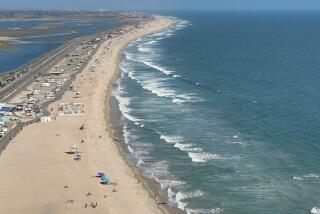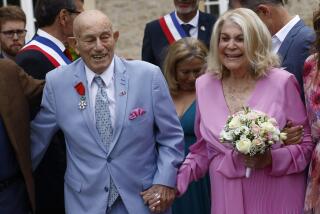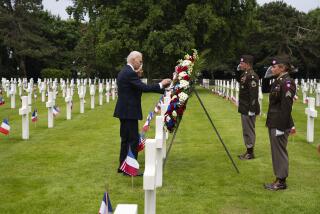NORMANDY : A peaceful present along the war-torn coast
- Share via
BAYEUX, France — The beaches and villages of Normandy expect record numbers of Allied visitors in 1989, when the nation celebrates the bicentennial of the French Revolution
The wind off the Atlantic was cold and unrelenting. Dark clouds covered the sky and dropped an occasional spattering of rain. We stared at the cliff beneath our feet, an eroded drop of 100 feet to the rocky beach, and wondered how any soldiers made it to the top.
At our backs, 44 years later, the landscape was still pockmarked with craters and strewn with giant blobs of concrete, the remains of Nazi bunkers smashed and upended by sheer bomb power from the sky.
Still the Allied soldiers came, the Yanks and the Britons and the Canadians, and still the enemy firing continued from the German bunkers that withstood the bombs. And still they came.
This was The Longest Day: D-day, June 6, 1944, when the Allies landed and began the liberation of German-occupied France and Europe. This day marked the beginning of the end of World War II.
“Lest we forget” is a phrase drummed into the consciousness of anyone from that day forward who comes to see the Normandy coast, isolated scallops of land between Cherbourg and Le Havre.
Those words are etched on the monuments that stand on lonely beaches like sentinels wrapped in the names of the young men who died there.
They are etched in the memory of every visitor to the hauntingly beautiful Normandy American Cemetery at Colleville-sur-Mer, with its perfect rows of white marble crosses, spreading as a sea of sadness across the rolling hillsides, an occasional Star of David among the rows.
Each marker lists the man’s name, rank, outfit, home state and the date he died. Here and there bouquets of flowers lie wilting.
The cemetery is the final destination of 9,386 American soldiers; 307 headstones mark the graves of “unknowns.” The remains of another 14,000 Americans originally buried in this region were returned to the United States at the request of relatives. In the midst of the crosses is a memorial that contains a bronze statue, “Spirit of American Youth.”
The sadness is overwhelming. It is beyond heroics, beyond bravery, beyond the concept of the glory of the battlefield. Here lies the end of life for thousands of young men. “Lest we forget.”
Bayeux is a perfect place from which to take day trips north to the various beaches -- Utah, Omaha, Gold, Juno and Sword -- and to the nearby cemeteries -- American, British and German.
And the Bayeux Memorial Museum 1944, opened a few years ago, has an extensive collection of memorabilia from the Battle of Normandy, including the day-by-day reports of the war as it was chronicled in American newspapers.
Other museums and monuments dot the coastline. One is the Pointe du Hoc Ranger Memorial, a single granite pylon atop a concrete bunker in the middle of what was Omaha Beach, where the 1st U.S. Infantry Division landed.
Rangers first scaled the 100-foot cliffs at dawn on D-day. Rough seas at the foot of the cliffs contributed to heavy losses in the first assault wave, and the Germans opened up with artillery when the second wave went in.
“A few assault groups reached the top of the beach,” it was reported, but they were pinned down by enemy fire for three days.
The 4th U.S. Infantry Division had better luck at Utah Beach just to the west, going ashore two miles away from its intended landing place and, fortunately, reaching a place where the enemy defenses were weak. They cleared the beach by midday and landed more than 23,000 men who headed inland to meet the 82nd Airborne Division.
Most Americans probably have images of World War II in the back of the mind: scenes from the movie “The Longest Day”; film clips of Allied soldiers floundering from landing barges into the chilly English Channel. And some remember well the reality of the coast of Normandy in 1944.
We stood in the intermittent light rain at Omaha Beach. A hillside away from the remains of the Nazi bunkers, black and white dairy cattle lay here and there in stunningly green meadows, obliviously serene.
Standing on this lonely point of history we knew that the casualties had been heavy, and that this rather ordinary strip of beach, with its pockmarked dunes and hillocks facing a quiet gray sea, had been the scene of extraordinary horror.
Mute testimony is in the upheaval of land, the bomb-made holes in the hills, craters and upended earth, like a moonscape covered with grass. French workers keep it as war carved it. They mow the grass up and down the hillocks, down inside the craters and around their edges, but there is no thought of bulldozing the area smooth. It is carefully tended and carefully preserved.
We climbed inside a bunker and imagined the nightmare of life within. The wooden ceiling and the supporting beams were charred black. Metal doors were fused shut. Chunks of concrete lay where they fell. Of the division of Germans ordered to hold this beachhead at all costs, we were told, two survived.
From the shelled cliffs and mute bunkers on the beach to the rows of white marble crosses flowing across the hills at Colleville-sur-Mer, the lesson of history stretches our minds and hearts to the breaking point. We won’t forget.
Bayeux is the first town in Normandy that was liberated after D-day. It welcomes visitors, especially Americans. It has nine small hotels.
We stayed in the central Hotel Reine Mathilde (16 rooms) between the 11th-century Gothic cathedral and the seminary that houses the historic Bayeux Tapestry (which presents an account of the 1066 Battle of Hastings). The Hotel du Lion d’Or has a Michelin star for its restaurant and pleasant old Norman decor (28 rooms). Hotel rates in Bayeux range from $45 to $80 U.S. for a double.
Bayeux is on the train line between Paris and Cherbourg, and town center is about a 10-minute walk from the station.
For more information, contact the French Government Tourist Office, 9454 Wilshire Blvd., Suite 303, Beverly Hills, Calif. 90212, (213) 271-6665
More to Read
Sign up for The Wild
We’ll help you find the best places to hike, bike and run, as well as the perfect silent spots for meditation and yoga.
You may occasionally receive promotional content from the Los Angeles Times.






